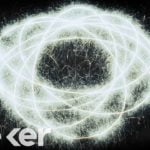The Strongest Force in the Universe Visualized Quantum Chromodynamics
The Strongest Force in the Universe Visualized Quantum Chromodynamics
QCD: Quantum Chromodynamics. How can positive protons be so close together in the nucleus, if they repel each other? Japanese physicist and Nobel laureate Hideki Yukawa sought to answer this question. He proposed the first significant theory of the strong nuclear force in 1934. He determined that this force must occur over a very small range.
Yukawa proposed that there must be a massive mediator particle that transfers this force between protons and neutrons. Using Einstein’s energy equivalence principle E=mc² and Heisenberg’s uncertainty principle, he got a mass of 100 mega electron volts (MeV). This is close to what was found later to be correct -138 MeV. Yukawa coined the term meson for this particle.
New mesons and other particles kept getting discovered. This created a crisis in particle physics because all particles could not be fundamental. In 1964, Murry Gell-Mann and George Zweig proposed that the various particles that interacted with the strong nuclear force could be explained if they were composed of fundamental particles called quarks.
Gell-Mann said were three types of quarks – up, down and strange. And they all experience the strong force. The quark model proposed that mesons where made of a quark anti-quark pair.
But another way quarks could combine is in groups of 3 quarks. These became baryons, such as protons and neutrons. A proton is made of two up quarks and a down quark. The neutron is made of two down quarks and an up quark.

